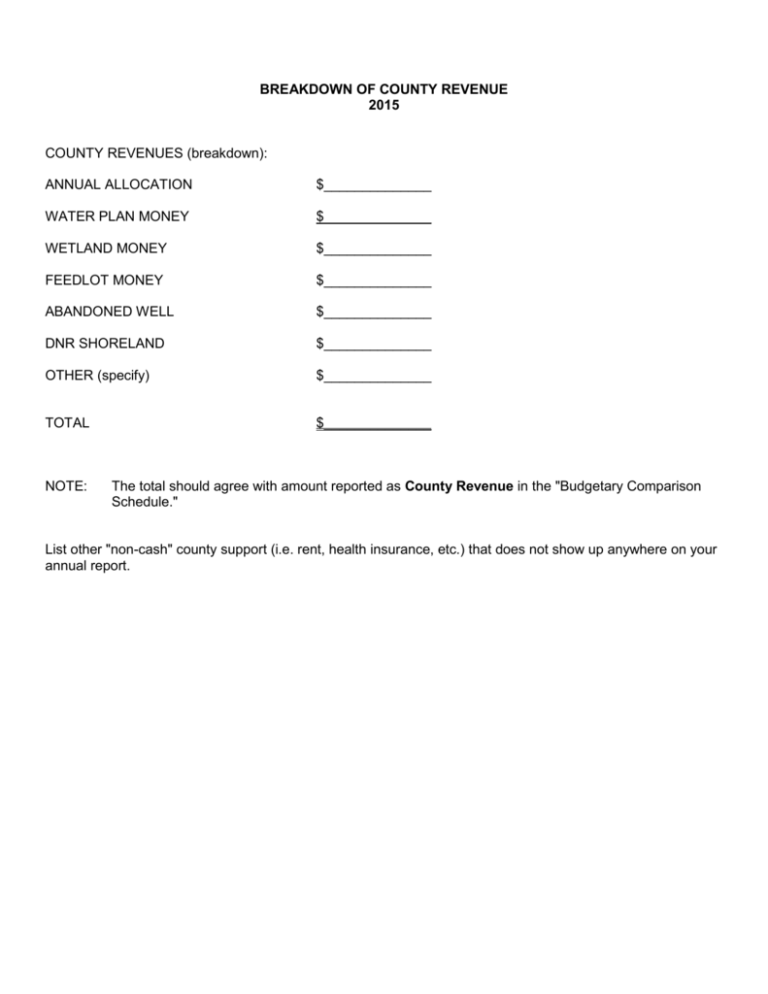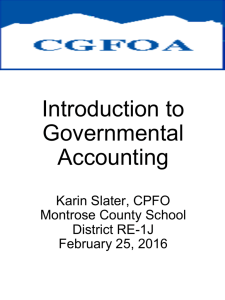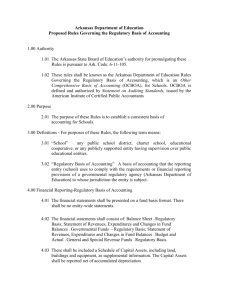2015 Notes to Financial Statements
advertisement

BREAKDOWN OF COUNTY REVENUE 2015 COUNTY REVENUES (breakdown): ANNUAL ALLOCATION $______________ WATER PLAN MONEY $______________ WETLAND MONEY $______________ FEEDLOT MONEY $______________ ABANDONED WELL $______________ DNR SHORELAND $______________ OTHER (specify) $______________ TOTAL $______________ NOTE: The total should agree with amount reported as County Revenue in the "Budgetary Comparison Schedule." List other "non-cash" county support (i.e. rent, health insurance, etc.) that does not show up anywhere on your annual report. UNEARNED REVENUE BREAKDOWN 2015 Balance of BWSR Service Grants: $ Balance of unencumbered BWSR Cost-Share Grants: Current fiscal year $ Previous fiscal year $ Balance of encumbered BWSR Cost-Share Grant (list each contract separately): FY Contract Amount Contract No. Total of all Cost-Share Encumbrances T&A Encumbered $___ Balance of County WCA Funds: $ Balance of County Water Plan Funds: $ Balance of other funds being deferred (list if any): $ $ $ Subtotal of other funds: $ TOTAL OF ALL UNEARNED REVENUE: $ (NAME) NOTES TO THE FINANCIAL STATEMENTS DECEMBER 31, 2015 Note 1 - Summary of Significant Accounting Policies The financial reporting policies of the (NAME) conform to generally accepted accounting principles. The Governmental Accounting Standards District (GASB) is responsible for establishing GAAP for state and local governments through its pronouncements (statements and interpretations). Changes in Accounting Principles During the year ended December 31, 2015, the District adopted GASB Statement No. 68, Accounting and Financial Reporting for Pensions - an amendment of GASB Statement No. 27 and GASB Statement No. 71, Pension Transition for Contributions Made Subsequent to the Measurement Date - an amendment of GASB Statement No. 68. Financial Reporting Entity The (NAME) is organized under the provisions of Minnesota Statutes Chapter 103C. The District is governed by a Board of Supervisors composed of five members nominated by voters of the District and elected to four-year terms by the voters of the County. The purpose of the District is to assist land occupiers in applying practices for the conservation of soil and water resources. These practices are intended to control wind and water erosion, pollution of lakes and streams, and damage to wetlands and wildlife habitats. The District provides technical and financial assistance to individuals, groups, Districts, and governments in reducing costly waste of soil and water resulting from soil erosion, sedimentation, pollution and improper land use. Each fiscal year the District develops a work plan which is used as a guide in using resources effectively to provide maximum conservation of all lands within its boundaries. The work plan includes guidelines for employees and technicians to follow in order to achieve the District's objectives. Generally accepted accounting principles require that the financial reporting entity include the primary government and component units for which the primary government is financially accountable. Under these principles the District does not have any component units. Government-Wide Financial Statements The government-wide financial statements (i.e. The Statement of Net Position and The Statement of Activities) report information on all of the nonfiduciary activities of the District. The Statement of Activities demonstrates the degree to which the direct expenses of a given function or segment are offset by program revenues. Direct expenses are those that are clearly identifiable with a specific function. The government-wide financial statements are reported using the economic resources measurement focus and the accrual basis of accounting. Revenues are recorded when earned and expenses are recorded when a liability is incurred, regardless of the timing of cash flows. Grants and similar items are recognized as revenues as soon as all eligibility requirements imposed by the provider have been met. (NAME) NOTES TO THE FINANCIAL STATEMENTS DECEMBER 31, 2015 Fund Financial Statements The government reports the General Fund as its only major governmental fund. The general fund accounts for all financial resources of the government. Governmental fund financial statements are reported using the current financial resources measurement focus and the modified accrual basis of accounting. Revenues are recognized as soon as they are both measurable and available. Revenues are considered to be available when they are collectible within the current period or soon enough thereafter to pay liabilities of the current period. For this purpose, the District considers all revenues, except reimbursement grants, to be available if they are collected within 60 days of the end of the current fiscal period. Reimbursement grants are considered available if they are collected within one year of the end of the current fiscal period. Expenditures are recorded when a liability is incurred under accrual accounting. Intergovernmental revenues are reported in conformity with the legal and contractual requirements of the individual programs. Generally, grant revenues are recognized when the corresponding expenditures are incurred. Investment earnings are recognized when earned. Other revenues are recognized when they are received in cash because they usually are not measurable until then. In accordance with Governmental Accounting Standards Board Statement No. 33, Accounting and Financial Reporting for Nonexchange Transactions, revenues for nonexchange transactions are recognized based on the principal characteristics of the revenue. Exchange transactions are recognized as revenue when the exchange occurs. Budget Information The District adopts an estimated revenue and expenditure budget for the general fund. Comparisons of estimated revenues and budgeted expenditures to actual are presented in the financial statements in accordance with generally accepted accounting principles. Amendments to the original budget require District approval. Appropriations lapse at yearend. The District does not use encumbrance accounting. Use of Estimates The preparation of financial statements in conformity with generally accepted accounting principles requires management to make estimates and assumptions which affect: the reported amounts of assets and liabilities, the disclosure of contingent assets and liabilities at the date of the financial statements, and the reported amounts of revenues and expenditures during the reporting period. Actual results could differ from those estimates. Assets, Deferred Outflows of Resources, Liabilities, Deferred Inflows of Resources, and Net Position Assets Investments are stated at fair value, except for non-negotiable certificates of deposit, which are on a cost basis, and short-term money market investments, which are stated at amortized cost. (NAME) NOTES TO THE FINANCIAL STATEMENTS DECEMBER 31, 2015 Capital assets are reported on a net (depreciated) basis. General capital assets are valued at historical or estimated historical cost. Liabilities Long-term liabilities, such as compensated absences, are accounted for as an adjustment to net position. Unearned Revenue Governmental funds and government-wide financial statements report unearned revenue in connection with resources that have been received, but not yet earned. Classification of Net Position Net position in the government-wide financial statements is classified in the following categories: Investment in capital assets – the amount of net position representing capital assets net of accumulated depreciation. Restricted net position – the amount of net position for which external restrictions have been imposed by creditors, grantors, contributors, or laws or regulations of other governments; and restrictions imposed by law through constitutional provisions or enabling legislation. Unrestricted net position – the amount of net position that does not meet the definition of restricted or investment in capital assets. Deferred Outflows/Inflows of Resources In addition to assets, the statement of financial position will sometimes report a separate section for deferred outflows of resources. This separate financial statement element, deferred outflows of resources, represents a consumption of net position that applies to future periods and so will not be recognized as an outflow of resources (expense/expenditure) until then. Currently, the District has only one item that qualifies for reporting in this category, deferred amounts related to their pension obligations. The length of the expense recognition period for deferred amounts is equal to the average of the expected remaining service lives of all employees that are provided with pensions through the pension plan, determined as of the beginning of the measurement period. In addition to liabilities, the statement of financial position will sometimes report a separate section for deferred inflows of resources. This separate financial statement element, deferred inflows of resources, represents an acquisition of net position that applies to future periods and will not be recognized as an inflow of resources (revenue) until that time. The District has only one type of item that qualifies for reporting in this category, amounts related to their pension obligations. These deferred amounts represent differences between projected and actual earnings on pension plan investments and are recognized over a five-year period. (NAME) NOTES TO THE FINANCIAL STATEMENTS DECEMBER 31, 2015 Classifications of Fund Balances Fund balance is divided into five classifications based primarily on the extent to which the District is bound to observe constraints imposed upon the use of the resources in the General Fund. The classifications are as follows: Nonspendable – the nonspendable fund balance category includes amounts that cannot be spent because they are not in spendable form, or legally or contractually required to be maintained intact. The “not in spendable form” criterion includes items that are not expected to be converted to cash. Restricted – fund balance is reported as restricted when constraints placed on the use of resources are either externally imposed by creditors (such as through debt covenants), grantors, contributors, or laws or regulations of other governments; or is imposed by law through constitutional provisions or enabling legislation. Committed – the committed fund balance classification includes amounts that can be used only for the specific purposes imposed by formal action (resolution) of the District. Those committed amounts cannot be used for any other purposes unless the District removes or changes the specified use by taking the same type of action (resolution) it employed to previously commit those amounts. Assigned – amounts in the assigned fund balance classification the District intends to use for specific purposes that do not meet the criteria to be classified as restricted or committed. In the General Fund, assigned amounts represent intended uses established by the District or the District Administrator who has been delegated that authority by District resolution. Unassigned – Unassigned fund balance is the residual classification for the general fund and includes all spendable amounts not contained in the other fund balance classifications. The District applies restricted resources first when expenditures are incurred for purposes for which either restricted or unrestricted (committed, assigned, and unassigned) amounts are available. Similarly, within unrestricted fund balance, committed amounts are reduced first followed by assigned, and then unassigned amounts when expenditures are incurred for purposes for which amounts in any of the unrestricted fund balance classifications could be used. Explanation of Adjustments Column in Statements Capital Assets: In the Statement of Net Position and Governmental Fund Balance Sheet, an adjustment is made if the District has capital assets. This adjustment equals the net book balance of capitalized assets as of the report date, and reconciles to the amount reported in the Capital Assets Note. Long-Term Liabilities: In the Statement of Net Position and Governmental Fund Balance Sheet, an adjustment is made to reflect the total Compensated Absence Liability the District has as of the report date. See note on Long-Term Liabilities. (NAME) NOTES TO THE FINANCIAL STATEMENTS DECEMBER 31, 2015 Depreciation and Change in Compensated Absences for the year: In the Statement of Activities and Governmental Fund Revenues, Expenditures and Changes in Fund Balance, the adjustment equals the total depreciation for the year reported, plus or minus the change in Compensated Absences between the reporting year and the previous year. This number is supported by figures in the note on Long-Term Liabilities. Vacation and Sick Leave Under the District's personnel policies, employees are granted vacation leave in varying amounts based on their length of service. Vacation leave accrual varies from ??? to ??? hours per month. Sick leave accrual is 8.6 hours per month. The limit on the accumulation of vacation leave is ??? hours and the limit on the accumulation of sick leave is ??? hours. Upon termination of employment from the District, employees are paid accrued vacation leave and sick leave hours. Risk Management The District is exposed to various risks of loss related to tort; theft of, damage to, and destruction of assets; errors and omissions; injuries to employees; workers’ compensation claims; and natural disasters. Property and casualty liabilities and workers’ compensation are insured through Minnesota Counties Intergovernmental Trust. The District retains risk for the deductible portion of the insurance. The amounts of these deductibles are considered immaterial to the financial statements. The Minnesota Counties Intergovernmental Trust is a public entity risk pool currently operated as a common risk management and insurance program for its members. The District pays an annual premium based on its annual payroll. There were no significant increases or reductions in insurance from the previous year or settlements in excess of insurance coverage for any of the past three fiscal years. Note 2 - Detailed Notes Capital Assets Changes in Capital Assets, Asset Capitalization and Depreciation. Equipment Less: Accumulated Depreciation Net Capital Assets Beginning Addition Deletion Ending $0 0 $0 $0 0 $0 0 $0 0 $0 (NAME) NOTES TO THE FINANCIAL STATEMENTS DECEMBER 31, 2015 The cost of property, plant and equipment is depreciated over the estimated useful lives of the related assets. Leasehold improvements are depreciated over the lesser of the term of the related lease or the estimated useful lives of the assets. Depreciation is computed on the straight-line method. The useful lives of property, plant and equipment for the purpose of computing depreciation is 5 to 10 years for Machinery and Equipment. Current year depreciation is $???. The District uses the threshold of $??? for capitalizing assets purchased. Unearned Revenue Unearned revenue represents unearned advances from the Minnesota Board of Water and Soil Resources (BWSR) for administrative service grants and for the cost-share program. Revenues will be recognized when the related program expenditures are recorded. Unearned revenue for the year ended December 31, 2015, consists of the following: BWSR Cost Share Programs, $???; Clean Water Funds, $???; BWSR Feedlot, $???; Total, $???. Long-Term Liabilities - Compensated Absences Payable Changes in long-term liabilities for the period ended December 31, 2015 are: Balance December 31, 2015 Net Change in Compensated Absences Balance December 31, 2015 $ 0 $ Deposits Minnesota Statutes 118A.02 and 118A.04 authorize the District to designate a depository for public funds and to invest in certificates of deposit. Minnesota Statutes 118A.03 requires that all District deposits be protected by insurance, surety bond, or collateral. The market value of collateral pledged shall be at least ten percent more than the amount on deposit plus accrued interest at the close of the financial institution’s banking day, not covered by insurance or bonds. Authorized collateral includes treasury bills, notes and bonds; issues of U.S. government agencies; general obligations rated “A” or better; revenue obligations rated “AA” or better; irrevocable standard letters of credit issued by the Federal Home Loan Bank; and certificates of deposit. Minnesota Statutes require that securities pledged as collateral be held in safekeeping in a restricted account at the Federal Reserve Bank or in an account at a trust department of a commercial bank or other financial institution that is not owned or controlled by the financial institution furnishing the collateral. Custodial Credit Risk Deposits Custodial credit risk is the risk that in the event of a financial institution failure, the District’s deposits may not be returned to it. The District does not have a deposit policy for custodial credit risk. As of December 31, 2015, the District’s deposits were not exposed to custodial credit risk. (NAME) NOTES TO THE FINANCIAL STATEMENTS DECEMBER 31, 2015 Note 3 - Defined Benefit Pension Plans Plan Description - Public Employees Retirement Association The District contributes to a cost-sharing multiple-employer defined pension plan administered by the Public Employee Retirement Association of Minnesota (PERA). The PERA provides retirement benefits as well as disability to members, and benefits to survivors upon death of eligible members. The plan and its benefits are established and administered in accordance with Minn. Statute Chapters 353 and 356. PERA issues a publicly available financial report that includes financial statements and required supplementary information. That report may be obtained by writing to the Public Employees Retirement Association, 60 Empire Drive, Suite 200, St. Paul, Minnesota 55103-1855. (NAME) NOTES TO THE FINANCIAL STATEMENTS DECEMBER 31, 2015 Funding Policy Minnesota Statutes Chapter 353 sets the rates for employer and employee contributions. These statutes are established and amended by the state legislature. The District makes annual contributions to the pension plans equal to the amount required by state statutes. Coordinated Plan members were required to contribute 6.5% of their annual covered salary. The District is required to contribute 7.5% of annual covered payroll. The District’s contributions to the Public Employees Retirement Fund for the years ending December 31, 2015, 2014 and 2013 were $???, $???, and $???, respectively. The District’s contributions were equal to the contractually required contributions for each year as set by Minnesota statute. Note 4 - Operating Leases The (SWCD) is the fiscal agent for the District and provides office space. Note 5 - Stewardship, Compliance and Accountability Excess of expenditures over budget – The General Fund had expenditures in excess of budget for the year as follows: Expenditures $????; Budget $????; Excess $????. Note 6 - Reconciliation of Fund Balance to Net Position Governmental Fund Balance, January 1 Plus: Excess of Revenue Over Expenditures Governmental Fund Balance, December 31 $0 0 $0 Adjustments from Fund Balance to Net Position: Plus: Capital Assets Plus: Deferred Outflows of Resources Less: Long-Term Liabilities Less: Deferred Inflows of Resources Net Position 0 $0 Note 7 - Reconciliation of Change in Fund Balance to Change in Net Position Change in Fund Balance $0 Capital Outlay The costs of capital assets are allocated over the capital assets’ useful lives at the government-wide level. (0) In the statement of activities certain operating expenses (including compensated absences) are measured by the amounts earned. (0) Change in Net Position $0







